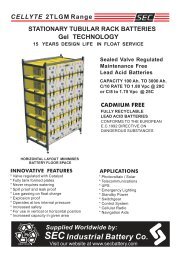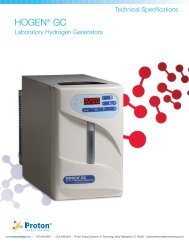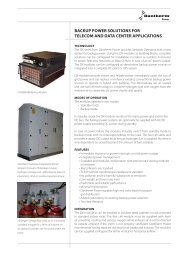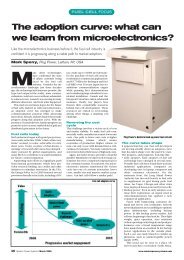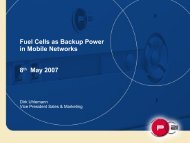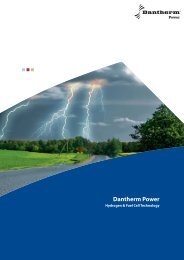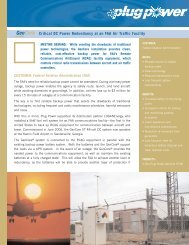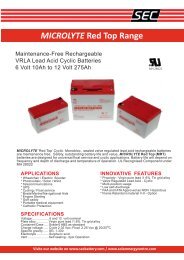A renaissance for alkaline fuel cells - Fuel Cell Markets
A renaissance for alkaline fuel cells - Fuel Cell Markets
A renaissance for alkaline fuel cells - Fuel Cell Markets
You also want an ePaper? Increase the reach of your titles
YUMPU automatically turns print PDFs into web optimized ePapers that Google loves.
INNOVATION<br />
faster kinetics of the peroxide reaction on the oxygen electrode<br />
results in lower irreversible losses. In practice it means that in<br />
strong alkali, the oxygen electrode has gained some extra<br />
100 mV. This can be seen in the Pourbaix diagram <strong>for</strong> the oxygen–hydrogen<br />
electrodes 8 .<br />
● System efficiency: While the efficiency of the typical low-temperature,<br />
low-pressure AFCs discussed earlier is by no means<br />
remarkable, the overall system efficiency is. The latest AFC generator<br />
designs from Astris Energi are a case in point. It was possible,<br />
owing to the inherent simplicity of the AFC architecture,<br />
to engineer a system with only three moving parts: an electrolyte<br />
circulation pump, an air pump or blower and a cooling<br />
fan. The entire budget <strong>for</strong> the ancillaries is 5% of the rated<br />
power, which also includes stack parasitic losses and losses due<br />
to venting and purging. This translates to less than 2.5% of the<br />
energy of the incoming <strong>fuel</strong>. There is no compression or<br />
humidification of gases; the pumps must overcome only the<br />
dynamic resistance of the moving fluids. The system efficiency<br />
rises to more than 60% at partial load, and remains above 50%<br />
throughout the operating range from 20 to 120% of full power.<br />
● Operating lifetime and durability: AFCs are rugged per<strong>for</strong>mers<br />
made of plastic, carbon and base metals (i.e. they do not require<br />
fragile graphite components or other exotic materials). Good<br />
operating lifetime is a given. The UTC Orbiter, <strong>for</strong> example, had<br />
a rated life of 2000 h, though in tests it exceeded 10 000 operating<br />
hours and individual stacks were tested beyond 15 000 h.<br />
Meanwhile, terrestrial AFCs have a rated life of 2000 h (Astris),<br />
with individual <strong>cells</strong> and electrodes tested to 5000–8000 h.<br />
● Failure modes and safety: AFCs tend not to fail catastrophically,<br />
but rather decline gradually in per<strong>for</strong>mance terms. Most manufacturers<br />
declare the end-of-life when per<strong>for</strong>mance falls below<br />
a predetermined level, usually caused by the corrosion and<br />
agglomeration of a catalyst and loss of repellence of the gas-diffusion<br />
electrodes. However, as long as the electrodes are in the<br />
wet state, <strong>fuel</strong> and oxidizer never meet and there is no danger<br />
of internal stack failure. Even if the electrolyte is removed<br />
be<strong>for</strong>e the reactants, wet electrodes will remain impervious to<br />
gases <strong>for</strong> many hours. This inherent safety should be considered<br />
an advantage over solid-electrolyte <strong>cells</strong> – PEMFCs and<br />
solid-oxide <strong>fuel</strong> <strong>cells</strong> (SOFCs) – where cracks, pinholes or<br />
hotspots in the electrolyte may lead to dangerous flash<br />
through, internal fire and stack destruction.<br />
● System design, balance-of-plant and materials of construction: One<br />
look inside an AFC generator built with the philosophy of<br />
“good per<strong>for</strong>mance at low cost” reveals inexpensive plastic<br />
parts, fittings, pipes and tubes. What’s more, the inherent simplicity<br />
of the balance-of-plant is striking. The <strong>fuel</strong>-delivery circuit<br />
uses a low-pressure regulator that feeds hydrogen to the<br />
stacks and a simple provision <strong>for</strong> purging of impurities from<br />
the stack. <strong>Fuel</strong> may be recirculated but often is “dead-ended” in<br />
the stack. A pump or a blower provides an air supply to the<br />
stacks in excess of the stoichiometric value. The electrolyte circuit<br />
with a pump, heat exchanger(s), filter and a cooling fan is<br />
usually the most complicated subsystem.<br />
● Capital cost: Five years ago, the cost of source materials <strong>for</strong> an<br />
AFC stack was just over €1100/kW. More recently, per<strong>for</strong>m-<br />
ance has been enhanced and the cost of materials brought<br />
down to €430–460/kW 9 . Meanwhile, Astris Energi reported a<br />
source material cost of $275/kW in 2004. With further evolution<br />
in per<strong>for</strong>mance, increased production volumes, reduced<br />
labour content and enhanced yields, it is conceivable that the<br />
cost of stacks will drop below the $400/kW level in annual<br />
quantities of 10 000 kW. If appropriate investment is <strong>for</strong>thcoming,<br />
the authors believe that, given sufficient volumes, with<br />
AFC stacks in the few hundred dollars range, the complete system<br />
selling price can break through the magic barrier of<br />
$1000/kW, with a healthy margin over the manufacturing cost.<br />
● Operating cost: While AFC technology has the potential to<br />
become the cheapest low-temperature <strong>fuel</strong> cell – and apart<br />
from high-temperature SOFCs, probably the cheapest <strong>fuel</strong> cell<br />
on the market – it also comes with a very low operational cost.<br />
Versatile per<strong>for</strong>mance is achieved with the least expensive<br />
industrial-grade hydrogen (99.9%) and even with unpurified,<br />
raw electrolytic hydrogen. In the platinum-free embodiment<br />
with circulating electrolyte, AFCs are insensitive to trace carbon<br />
oxides, and inert to most other impurities. Cost of the consumables<br />
(soda lime and, in some cases, potassium hydroxide)<br />
may add some 0.2–2 cents/kWh 1 .<br />
Commercial opportunities<br />
Right now, <strong>fuel</strong> <strong>cells</strong> of all types are being corralled into applications<br />
where they can potentially displace incumbent powergeneration<br />
schemes. As a result, the approach to market entry is<br />
largely based on the cost dynamic that the <strong>fuel</strong> cell can achieve<br />
compared with the existing technology of choice. In most<br />
cases, comparing only the capital or purchase cost is not currently<br />
sufficient to prove the business case positive <strong>for</strong> <strong>fuel</strong> <strong>cells</strong>.<br />
In many cases, the benefits of <strong>fuel</strong>-cell operation must be<br />
proved based on a total cost of ownership owing to higher reliability<br />
and elimination of peripheral equipment (e.g. because<br />
of quiet or emission-free operation). The value proposition<br />
delivered by AFCs is similar to other low-temperature <strong>fuel</strong> <strong>cells</strong>,<br />
namely PEMFCs, with the added advantage that both capital<br />
cost and operations cost are considerably lower. Initial applications<br />
are expected to be as backup power sources and in light<br />
mobility, though declining AFC price points could in time open<br />
up additional markets.<br />
● Backup power: The list of applications that must be either shutdown<br />
in a controlled manner or operated <strong>for</strong> long periods without<br />
their normal power supply is a long one and includes<br />
mechanical systems (such as elevators) and all manner of hardware<br />
in telecommunications and computing networks. Today,<br />
the majority of backup schemes rely heavily on banks of leadacid<br />
batteries, sometimes supplemented by a diesel or gasoline<br />
generator. <strong>Fuel</strong> <strong>cells</strong> that can be produced economically will be<br />
able to deliver increased per<strong>for</strong>mance and offer a savings to the<br />
operator <strong>for</strong> a variety of backup power applications owing to<br />
decreased maintenance, simpler installation and enhanced<br />
reliability. There is an incredible advantage to having a power<br />
supply that is fully independent from the primary supply. In<br />
times of extended power outage, <strong>for</strong> example, additional gas<br />
cylinders can be delivered to power the backup power system,<br />
R EPRINTED WITH PERMISSION. COPYRIGHT I NSTITUTE OF P HYSICS AND IOP PUBLISHING 2006




